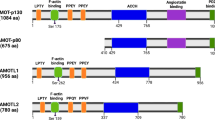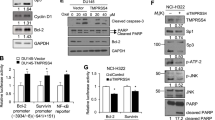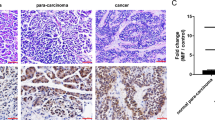Abstract
Inhibitor of apoptosis (IAP) proteins are a family comprised of a total of eight mammalian members that were initially described to act as endogenous inhibitors of caspases. In addition, extensive evidence has been accumulated over the last years showing that IAP proteins can regulate various signal transduction pathways, thereby exerting non-apoptotic functions beyond the inhibition of apoptosis. For example, IAP proteins have been implied in the control of cell motility, migration, invasion and metastasis. However, currently the question is controversially discussed whether or not they positively or negatively control these processes. As small-molecule inhibitors of IAP proteins have entered the stage of clinical evaluation as experimental cancer therapeutics, a better understanding of their various cellular effects will be critical for their rational use in the treatment of human diseases.
This is a preview of subscription content, access via your institution
Access options
Subscribe to this journal
Receive 50 print issues and online access
$259.00 per year
only $5.18 per issue
Buy this article
- Purchase on Springer Link
- Instant access to full article PDF
Prices may be subject to local taxes which are calculated during checkout




Similar content being viewed by others
References
Fulda S, Vucic D . Targeting IAP proteins for therapeutic intervention in cancer. Nat Rev Drug Discov 2012; 11: 109–124.
Crook NE, Clem RJ, Miller LK . An apoptosis-inhibiting baculovirus gene with a zinc finger-like motif. J Virol 1993; 67: 2168–2174.
Birnbaum MJ, Clem RJ, Miller LK . An apoptosis-inhibiting gene from a nuclear polyhedrosis virus encoding a polypeptide with Cys/His sequence motifs. J Virol 1994; 68: 2521–2528.
Salvesen GS, Duckett CS . IAP proteins: blocking the road to death’s door. Nat Rev Mol Cell Biol 2002; 3: 401–410.
Ndubaku C, Cohen F, Varfolomeev E, Vucic D . Targeting inhibitor of apoptosis (IAP) proteins for therapeutic intervention. Future Med Chem 2009; 1: 1509–1525.
Srinivasula SM, Hegde R, Saleh A, Datta P, Shiozaki E, Chai J et al. A conserved XIAP-interaction motif in caspase-9 and Smac/DIABLO regulates caspase activity and apoptosis. Nature 2001; 410: 112–116.
Shiozaki EN, Chai J, Rigotti DJ, Riedl SJ, Li P, Srinivasula SM et al. Mechanism of XIAP-mediated inhibition of caspase-9. Mol Cell 2003; 11: 519–527.
Huang Y, Park YC, Rich RL, Segal D, Myszka DG, Wu H . Structural basis of caspase inhibition by XIAP: differential roles of the linker versus the BIR domain. Cell 2001; 104: 781–790.
Chai J, Shiozaki E, Srinivasula SM, Wu Q, Datta P, Alnemri ES et al. Structural basis of caspase-7 inhibition by XIAP. Cell 2001; 104: 769–780.
Riedl SJ, Renatus M, Schwarzenbacher R, Zhou Q, Sun C, Fesik SW et al. Structural basis for the inhibition of caspase-3 by XIAP. Cell 2001; 104: 791–800.
Silke J, Ekert PG, Day CL, Hawkins CJ, Baca M, Chew J et al. Direct inhibition of caspase 3 is dispensable for the anti-apoptotic activity of XIAP. Embo J 2001; 20: 3114–3123.
Schile AJ, Garcia-Fernandez M, Steller H . Regulation of apoptosis by XIAP ubiquitin-ligase activity. Genes Dev 2008; 22: 2256–2266.
Vaux DL, Silke J . IAPs, RINGs and ubiquitylation. Nat Rev Mol Cell Biol 2005; 6: 287–297.
Varfolomeev E, Vucic D . (Un)expected roles of c-IAPs in apoptotic and NFkappaB signaling pathways. Cell Cycle 2008; 7: 1511–1521.
Vucic D, Dixit VM, Wertz IE . Ubiquitylation in apoptosis: a post-translational modification at the edge of life and death. Nat Rev Mol Cell Biol 2011; 12: 439–452.
Dueber EC, Schoeffler AJ, Lingel A, Elliott JM, Fedorova AV, Giannetti AM et al. Antagonists induce a conformational change in cIAP1 that promotes autoubiquitination. Science 2011; 334: 376–380.
Lopez J, John SW, Tenev T, Rautureau GJ, Hinds MG, Francalanci F et al. CARD-mediated autoinhibition of cIAP1’s E3 ligase activity suppresses cell proliferation and migration. Mol Cell 2011; 42: 569–583.
Blankenship JW, Varfolomeev E, Goncharov T, Fedorova AV, Kirkpatrick DS, Izrael-Tomasevic A et al. Ubiquitin binding modulates IAP antagonist-stimulated proteasomal degradation of c-IAP1 and c-IAP2(1). Biochem J 2009; 417: 149–160.
Gyrd-Hansen M, Darding M, Miasari M, Santoro MM, Zender L, Xue W et al. IAPs contain an evolutionarily conserved ubiquitin-binding domain that regulates NF-kappaB as well as cell survival and oncogenesis. Nat Cell Biol 2008; 10: 1309–1317.
Hauser HP, Bardroff M, Pyrowolakis G, Jentsch S . A giant ubiquitin-conjugating enzyme related to IAP apoptosis inhibitors. J Cell Biol 1998; 141: 1415–1422.
Chen Z, Naito M, Hori S, Mashima T, Yamori T, Tsuruo T . A human IAP-family gene, apollon, expressed in human brain cancer cells. Biochem Biophys Res Commun 1999; 264: 847–854.
Jeyaprakash AA, Klein UR, Lindner D, Ebert J, Nigg EA, Conti E . Structure of a Survivin-Borealin-INCENP core complex reveals how chromosomal passengers travel together. Cell 2007; 131: 271–285.
Liston P, Roy N, Tamai K, Lefebvre C, Baird S, Cherton-Horvat G et al. Suppression of apoptosis in mammalian cells by NAIP and a related family of IAP genes. Nature 1996; 379: 349–353.
Wilmanski JM, Petnicki-Ocwieja T, Kobayashi KS . NLR proteins: integral members of innate immunity and mediators of inflammatory diseases. J Leukoc Biol 2008; 83: 13–30.
Eckelman BP, Salvesen GS, Scott FL . Human inhibitor of apoptosis proteins: why XIAP is the black sheep of the family. EMBO Rep 2006; 7: 988–994.
Vucic D, Franklin MC, Wallweber HJ, Das K, Eckelman BP, Shin H et al. Engineering ML-IAP to produce an extraordinarily potent caspase 9 inhibitor: implications for Smac-dependent anti-apoptotic activity of ML-IAP. Biochem J 2005; 385: 11–20.
Scheidereit C . IκB kinase complexes: gateways to NF-κB activation and transcription. Oncogene 2006; 25: 6685–6705.
Bertrand MJ, Milutinovic S, Dickson KM, Ho WC, Boudreault A, Durkin J et al. cIAP1 and cIAP2 facilitate cancer cell survival by functioning as E3 ligases that promote RIP1 ubiquitination. Mol Cell 2008; 30: 689–700.
Varfolomeev E, Goncharov T, Fedorova AV, Dynek JN, Zobel K, Deshayes K et al. c-IAP1 and c-IAP2 are critical mediators of tumor necrosis factor alpha (TNFα)-induced NF-κB activation. J Biol Chem 2008; 283: 24295–24299.
Mahoney DJ, Cheung HH, Mrad RL, Plenchette S, Simard C, Enwere E et al. Both cIAP1 and cIAP2 regulate TNFalpha-mediated NF-kappaB activation. Proc Natl Acad Sci USA 2008; 105: 11778–11783.
Dynek JN, Goncharov T, Dueber EC, Fedorova AV, Izrael-Tomasevic A, Phu L et al. c-IAP1 and UbcH5 promote K11-linked polyubiquitination of RIP1 in TNF signalling. Embo J 2010; 29: 4198–4209.
Haas TL, Emmerich CH, Gerlach B, Schmukle AC, Cordier SM, Rieser E et al. Recruitment of the linear ubiquitin chain assembly complex stabilizes the TNF-R1 signaling complex and is required for TNF-mediated gene induction. Mol Cell 2009; 36: 831–844.
Keats JJ, Fonseca R, Chesi M, Schop R, Baker A, Chng WJ et al. Promiscuous mutations activate the noncanonical NF-kappaB pathway in multiple myeloma. Cancer Cell 2007; 12: 131–144.
Annunziata CM, Davis RE, Demchenko Y, Bellamy W, Gabrea A, Zhan F et al. Frequent engagement of the classical and alternative NF-kappaB pathways by diverse genetic abnormalities in multiple myeloma. Cancer cell 2007; 12: 115–130.
Grech AP, Amesbury M, Chan T, Gardam S, Basten A, Brink R . TRAF2 differentially regulates the canonical and noncanonical pathways of NF-κB activation in mature B cells. Immunity 2004; 21: 629–642.
He JQ, Zarnegar B, Oganesyan G, Saha SK, Yamazaki S, Doyle SE et al. Rescue of TRAF3-null mice by p100 NF-kappa B deficiency. J Exp Med 2006; 203: 2413–2418.
Demchenko YN, Glebov OK, Zingone A, Keats JJ, Bergsagel PL, Kuehl WM . Classical and/or alternative NF-kappaB pathway activation in multiple myeloma. Blood 2010; 115: 3541–3552.
Varfolomeev E, Blankenship JW, Wayson SM, Fedorova AV, Kayagaki N, Garg P et al. IAP antagonists induce autoubiquitination of c-IAPs, NF-kappaB activation, and TNFalpha-dependent apoptosis. Cell 2007; 131: 669–681.
Vince JE, Wong WW, Khan N, Feltham R, Chau D, Ahmed AU et al. IAP antagonists target cIAP1 to induce TNFalpha-dependent apoptosis. Cell 2007; 131: 682–693.
Vince JE, Chau D, Callus B, Wong WW, Hawkins CJ, Schneider P et al. TWEAK-FN14 signaling induces lysosomal degradation of a cIAP1-TRAF2 complex to sensitize tumor cells to TNFalpha. J Cell Biol 2008; 182: 171–184.
Csomos RA, Wright CW, Galban S, Oetjen KA, Duckett CS . Two distinct signalling cascades target the NF-kappaB regulatory factor c-IAP1 for degradation. Biochem J 2009; 420: 83–91.
Vucic D in 13th International TNF Conference (Awaji, Japan, 2011) 2011.
Xiao G, Harhaj EW, Sun SC . NF-κB-inducing kinase regulates the processing of NF-κB2 p100. Mol Cell 2001; 7: 401–409.
Senftleben U, Cao Y, Xiao G, Greten FR, Krahn G, Bonizzi G et al. Activation by IKKα of a second, evolutionary conserved, NF-κB signaling pathway. Science 2001; 293: 1495–1499.
Dejardin E . The alternative NF-kappaB pathway from biochemistry to biology: pitfalls and promises for future drug development. Biochem Pharmacol 2006; 72: 1161–1179.
Varfolomeev E, Goncharov T, Maecker H, Zobel K, Komuves LG, Deshayes K et al. Cellular inhibitors of apoptosis are global regulators of NF-kappaB and MAPK activation by members of the TNF family of receptors. Sci Signal 2012; 5: ra22.
Hofer-Warbinek R, Schmid JA, Stehlik C, Binder BR, Lipp J, de Martin R . Activation of NF-kappa B by XIAP, the X chromosome-linked inhibitor of apoptosis, in endothelial cells involves TAK1. J Biol Chem 2000; 275: 22064–22068.
Lu M, Lin S-C, Huang Y, Kang YJ, Rich R, Lo Y-C et al. XIAP induces NF-kappaB activation via the BIR1/TAB1 interaction and BIR1 dimerization. Mol Cell 2007; 26: 689–702.
Asselin E, Mills GB, Tsang BK . XIAP regulates Akt activity and caspase-3-dependent cleavage during cisplatin-induced apoptosis in human ovarian epithelial cancer cells. Cancer Res 2001; 61: 1862–1868.
Birkey Reffey S, Wurthner JU, Parks WT, Roberts AB, Duckett CS . X-linked inhibitor of apoptosis protein functions as a cofactor in transforming growth factor-beta signaling. J Biol Chem 2001; 276: 26542–26549.
Sanna MG, da Silva Correia J, Ducrey O, Lee J, Nomoto K, Schrantz N et al. IAP suppression of apoptosis involves distinct mechanisms: the TAK1/JNK1 signaling cascade and caspase inhibition. Mol Cell Biol 2002; 22: 1754–1766.
Bertrand MJ, Doiron K, Labbe K, Korneluk RG, Barker PA, Saleh M . Cellular inhibitors of apoptosis cIAP1 and cIAP2 are required for innate immunity signaling by the pattern recognition receptors NOD1 and NOD2. Immunity 2009; 30: 789–801.
Krieg A, Correa RG, Garrison JB, Le Negrate G, Welsh K, Huang Z et al. XIAP mediates NOD signaling via interaction with RIP2. Proc Natl Acad Sci USA 2009; 106: 14524–14529.
Damgaard RB, Nachbur U, Yabal M, Wong WW, Fiil BK, Kastirr M et al. The ubiquitin ligase XIAP recruits LUBAC for NOD2 signaling in inflammation and innate immunity. Mol Cell 2012; 46: 746–758.
Tseng PH, Matsuzawa A, Zhang W, Mino T, Vignali DA, Karin M . Different modes of ubiquitination of the adaptor TRAF3 selectively activate the expression of type I interferons and proinflammatory cytokines. Nat Immunol 2010; 11: 70–75.
Labbe K, McIntire CR, Doiron K, Leblanc PM, Saleh M . Cellular inhibitors of apoptosis proteins cIAP1 and cIAP2 are required for efficient caspase-1 activation by the inflammasome. Immunity 2011; 35: 897–907.
Vince JE, Wong WW, Gentle I, Lawlor KE, Allam R, O’Reilly L et al. Inhibitor of apoptosis proteins limit RIP3 kinase-dependent interleukin-1 activation. Immunity 2012; 36: 215–227.
Mao AP, Li S, Zhong B, Li Y, Yan J, Li Q et al. Virus-triggered ubiquitination of TRAF3/6 by cIAP1/2 is essential for induction of interferon-beta (IFN-beta) and cellular antiviral response. J Biol Chem 2010; 285: 9470–9476.
Beug ST, Cheung HH, Lacasse EC, Korneluk RG . Modulation of immune signalling by inhibitors of apoptosis. Trends Immunol 2012; 33: 535–545.
Lopez J, Meier P . To fight or die - inhibitor of apoptosis proteins at the crossroad of innate immunity and death. Curr Opin Cell Biol 2010; 22: 872–881.
Garcia-Fernandez M, Kissel H, Brown S, Gorenc T, Schile AJ, Rafii S et al. Sept4/ARTS is required for stem cell apoptosis and tumor suppression. Genes Dev 2010; 24: 2282–2293.
Geisbrecht ER, Montell DJ . A role for Drosophila IAP1-mediated caspase inhibition in Rac-dependent cell migration. Cell 2004; 118: 111–125.
Launay S, Hermine O, Fontenay M, Kroemer G, Solary E, Garrido C . Vital functions for lethal caspases. Oncogene 2005; 24: 5137–5148.
Liu J, Zhang D, Luo W, Yu J, Li J, Yu Y et al. E3 ligase activity of XIAP RING domain is required for XIAP-mediated cancer cell migration, but not for its RhoGDI binding activity. PLoS One 2012; 7: e35682.
Yu J, Zhang D, Liu J, Li J, Yu Y, Wu XR et al. RhoGDI SUMOylation at Lys-138 increases its binding activity to Rho GTPase and its inhibiting cancer cell motility. J Biol Chem 2012; 287: 13752–13760.
Liu J, Zhang D, Luo W, Yu Y, Yu J, Li J et al. X-linked inhibitor of apoptosis protein (XIAP) mediates cancer cell motility via Rho GDP dissociation inhibitor (RhoGDI)-dependent regulation of the cytoskeleton. J Biol Chem 2011; 286: 15630–15640.
Tian S, Mewani RR, Kumar D, Li B, Danner MT, Ahmad I et al. Interaction and stabilization of X-linked inhibitor of apoptosis by Raf-1 protein kinase. Int J Oncol 2006; 29: 861–867.
Ahn S, Park H . XIAP is essential for shear stress-enhanced Tyr-576 phosphorylation of FAK. Biochem Biophys Res Commun 2010; 399: 256–261.
Ahn S, Kim HJ, Chi SG, Park H . XIAP reverses various functional activities of FRNK in endothelial cells. Biochem Biophys Res Commun 2012; 419: 419–424.
Kim J, Ahn S, Ko YG, Boo YC, Chi SG, Ni CW et al. X-linked inhibitor of apoptosis protein controls alpha5-integrin-mediated cell adhesion and migration. Am J Physiol Heart Circulatory Physiol 2010; 299: H300–H309.
Glinsky GV . Genomic models of metastatic cancer: functional analysis of death-from-cancer signature genes reveals aneuploid, anoikis-resistant, metastasis-enabling phenotype with altered cell cycle control and activated Polycomb Group (PcG) protein chromatin silencing pathway. Cell Cycle 2006; 5: 1208–1216.
Mehrotra S, Languino LR, Raskett CM, Mercurio AM, Dohi T, Altieri DC . IAP regulation of metastasis. Cancer Cell 2010; 17: 53–64.
Min C, Eddy SF, Sherr DH, Sonenshein GE . NF-kappaB and epithelial to mesenchymal transition of cancer. J Cell Biochem 2008; 104: 733–744.
Fingas CD, Blechacz BR, Smoot RL, Guicciardi ME, Mott J, Bronk SF et al. A smac mimetic reduces TNF related apoptosis inducing ligand (TRAIL)-induced invasion and metastasis of cholangiocarcinoma cells. Hepatology 2010; 52: 550–561.
Dogan T, Harms GS, Hekman M, Karreman C, Oberoi TK, Alnemri ES et al. X-linked and cellular IAPs modulate the stability of C-RAF kinase and cell motility. Nat Cell Biol 2008; 10: 1447–1455.
Oberoi TK, Dogan T, Hocking JC, Scholz RP, Mooz J, Anderson CL et al. IAPs regulate the plasticity of cell migration by directly targeting Rac1 for degradation. Embo J 2012; 31: 14–28.
Oberoi-Khanuja TK, Karreman C, Larisch S, Rapp UR, Rajalingam K . Role of melanoma inhibitor of apoptosis (ML-IAP) protein, a member of the baculoviral IAP repeat (BIR) domain family, in the regulation of C-RAF kinase and cell migration. J Biol Chem 2012; 287: 28445–28455.
Dhillon AS, Hagan S, Rath O, Kolch W . MAP kinase signalling pathways in cancer. Oncogene 2007; 26: 3279–3290.
Heasman SJ, Ridley AJ . Mammalian Rho GTPases: new insights into their functions from in vivo studies. Nat Rev Mol Cell Biol 2008; 9: 690–701.
Mollereau B, Perez-Garijo A, Bergmann A, Miura M, Gerlitz O, Ryoo HD et al. Compensatory proliferation and apoptosis-induced proliferation: a need for clarification. Cell Death Differ 2013; 20: 181.
Acknowledgements
The expert secretarial assistance of C Hugenberg is greatly appreciated. This work has been partially supported by grants from the Deutsche Forschungsgemeinschaft, the Ministerium für Bildung und Forschung (01GM0871, 01GM1104C), European Community and Jose Carreras Stiftung.
Author information
Authors and Affiliations
Corresponding author
Ethics declarations
Competing interests
The author declares no conflict of interest.
Rights and permissions
About this article
Cite this article
Fulda, S. Regulation of cell migration, invasion and metastasis by IAP proteins and their antagonists. Oncogene 33, 671–676 (2014). https://doi.org/10.1038/onc.2013.63
Received:
Revised:
Accepted:
Published:
Issue Date:
DOI: https://doi.org/10.1038/onc.2013.63
Keywords
This article is cited by
-
Hyaluronan-CD44 Interaction Regulates Mouse Retinal Progenitor Cells Migration, Proliferation and Neuronal Differentiation
Stem Cell Reviews and Reports (2023)
-
Effects and mechanisms of GSG2 in esophageal cancer progression
Journal of Cancer Research and Clinical Oncology (2023)
-
The hard clam genome reveals massive expansion and diversification of inhibitors of apoptosis in Bivalvia
BMC Biology (2021)
-
OTUD7B suppresses Smac mimetic-induced lung cancer cell invasion and migration via deubiquitinating TRAF3
Journal of Experimental & Clinical Cancer Research (2020)
-
The X-linked inhibitor of apoptosis protein (XIAP) is involved in melanoma invasion by regulating cell migration and survival
Cellular Oncology (2019)



